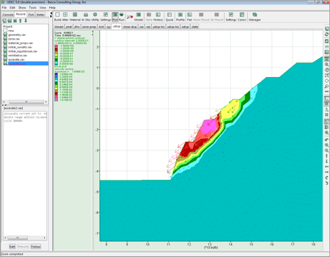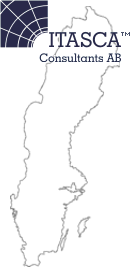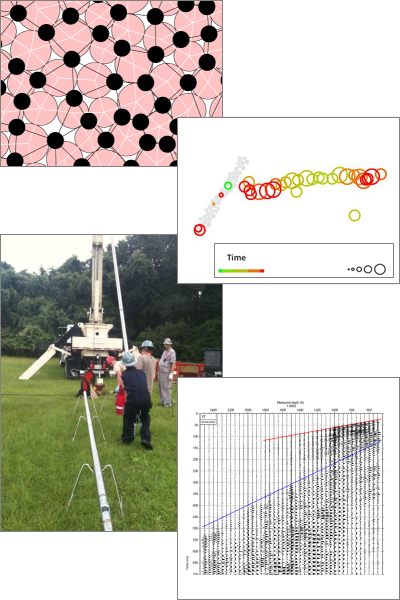
I would like to call your attention to the item in the International section below, which describes the reorganization of our office in Sweden. We are very excited about this development, and anticipate that it will be an excellent opportunity for us to expand our activities in Scandinavia. We will have news of a similar nature regarding our operations in China in our next issue.
— Loren Lorig, Chief Executive Officer
Consulting
|
Microseismic Monitoring, CCS, and ASC
Clockwise from top left: Reservoirs, flow paths and bonds in compacted bonded assembly of particles; induced microseismic events for jointed model with low permeability; recorded traces from Geochain Slim; photo of downhole sparker during field test. PFC3D models were used to predict the seismic response of a typical reservoir to the injection of compressed CO2. Microseismicity was only observed in models with permeable pre-existing fractures under the highest injection pressure, with activity increasing with temperature. In all cases, low-magnitude activity is expected as a result of the treatment. Software tools have been implemented to aid the processing of microseismic data recorded in a low signal-to-noise environment. The feasibility of using a down-hole "Sparker" based on a high voltage discharge device was tested as well. The project demonstrates successful commercialization of existing microseismic technologies for CCS monitoring applications. |
Software
|
UDEC 5.0 has been released. This new version features an improved GUI, faster calculations, improved accuracy, added/improved structural elements, a new fluid flow model, an improved automatic Voronoi joint generator, new/extended plotting capabilities, automatic zone and joint model generation, enhanced documentation, hidden construction joints, and more. Find out what's new in version 5.0.  Screen shot of UDEC 5.0; click here or on the image FLAC3D/3DEC Survey The capability to create models of great geometric complexity has become an increasingly important factor in our 3d modeling codes. To help guide us in our software developments in this area, we have developed a short, eight question survey that takes less than two minutes to complete. If this is an area that impacts you in the work that you do, and if you would like to share your opinions on the subject, then we invite you to take the survey. |
Update Alert: Current Versions updated since March 1, 2011: |
International

New Office
Itasca International Inc. is pleased to announce that its office in Sweden has been reorganized. The former office, Itasca Geomekanik AB, has closed, and the new office has begun operations under the name Itasca Consultants AB (ICAB). Initially, the work of the office will focus on the local Swedish mining industry with an emphasis on LKAB (Kiruna Mine and Malmberget), the civil tunneling industry in the Stockholm region, and the MMT2 project. ICAB staff are cooperating with Luleå University of Technology and the Royal Institute of Technology in different research areas. Other long term international projects for Codelco (El Teniente) and University of Alberta are also being handled by ICAB. The office is staffed by Jonny Sjöberg and Diego Mas Ivars, both longtime employees and collaborators with Itasca. They will seek to add more staff as operations are brought fully up to speed. As with its predecessor office, in addition to offering geomechanics consulting services, ICAB will act as the Itasca software sales agent for Sweden, Norway, and Iceland.
Training

Petroleum Geomechanics Training
Itasca Houston is offering a two-part, three/five-day course in petroleum geomechanics, July 11-15, 2011. The course is intended for geoscientists, reservoir engineers, drilling engineers, and completions engineers with no significant background in geomechanics, who have 3+ years of experience and are currently working with unconventional resources or other geomechanical challenges. The focus of the courses is geomechanics and its applications to unconventional developments; that is, the effects of stress, pore pressure, temperature, and mechanical properties in petroleum applications — and, in particular, tight and shale gas operations. The course will be taught principally by Dr. Neal Nagel, a geomechanics specialist with more than 20 years of global oilfield geomechanics experience. He will be assisted by his colleagues from Itasca Houston, Drs. Sanchez-Nagel and Gil. Course outlines, descriptions, and registration information are available now on the Itasca training page.

Spring Training Report
The annual Itasca Software introductory training courses are complete. From early-April to early-May, over 40 people received training on five Itasca codes. Additional courses for FLAC and FLAC3D have been scheduled for this October. As with all our general training courses, registration is available on a first-come, first-served basis, so sign up now if you are interested. Both courses will be held in the office of Itasca Consulting Group, Inc. in Minneapolis. The dates for the courses are:
FLAC - Oct. 12-14, 2011
FLAC3D - Oct. 19-21, 2011
Full course descriptions, registration, and price information are available online.
Conferences

45th U.S. Rock Mechanics/
Geomechanics Symposium
Itasca International Inc. will be represented on several fronts at the upcoming ARMA conference, June 27-29 in San Francisco. Matt Pierce of Itasca Consulting Group (ICG) will be chairing Session 4, "Rock Mechanics in Cave Mining I," on Monday, June 27, from 8-9:30am. Ivan Gil of Itasca Houston has the paper "Effect of Field Parameters upon Hydraulic Fractures Propagation in Naturally Fractured Reservoirs - Getting Control of the Process" as part of session 25 on June 28. Yanhui Han of ICG has the paper "Hydro-mechanical Response of Cracked Single-jointed Slope Subjected to Constant Infiltration" in Session 23 on June 28. And Itasca CEO Loren Lorig will be delivering the invited talk "Slope Model Update" as part of Session 36. In addition, work performed by Itasca Australia will be presented in the paper, "Numerial Back-Analysis of Structurally Controlled Cave Initiation and Propagation at the Henderson Mine". If you are planning to attend the conference, keep an eye out for our people or drop in on their sessions.
Staff Publications
Herbst, M., M. Pohl and H. Konietzky. (2010) "Numerische Simulation der Interaktion Wasser --- Deckwerk Im Tidegebiet (in German)," in Proceedings, Dresdner Wasserbaukolloquium 2010, "Wasserbau und Umwelt - Anforderungen, Methoden, Lösungen" (March 2010). Technische Universität Dresden.
Reyes-Montes, J. M. et al. (2010) "Microseismic Tools for the Analysis of the Interaction Between Open Pit and Underground Developments," in Caving 2010 (Proceedings, Second International Symposium on Block and Sublevel Caving, Perth, Australia, April 2010), pp. 119-132, Y. Potvin, Ed. Perth: Australian Centre for Geomechanics.
Sainsbury, D. P., B. L. Sainsbury and L. L. Lorig. (2010) "Investigation of Caving Induced Subsidence at the Abandoned Grace Mine," in Caving 2010 (Proceedings, Second International Symposium on Block and Sublevel Caving, Perth, Australia, April 2010), pp. 189-204, Y. Potvin, Ed. Perth: Australian Centre for Geomechanics.
Sainsbury, B. L. (2010) "Sensitivities in the Numerical Assessment of Cave Propagation," in Caving 2010 (Proceedings, Second International Symposium on Block and Sublevel Caving, Perth, Australia, April 2010), pp. 523-535, Y. Potvin, Ed. Perth: Australian Centre for Geomechanics.
Pierce, M., D. K. Weatherley and T. Kojovic. (2010) "A Hybrid Methodology for Secondary Fragmentation Prediction in Cave Mines," in Caving 2010 (Proceedings, Second International Symposium on Block and Sublevel Caving, Perth, Australia, April 2010), pp. 567-581, Y. Potvin, Ed. Perth: Australian Centre for Geomechanics.
Jobmann, M., and D. Billaux. (2010) "Fractal Model for Permeability Calculation from Porosity and Pore Radius Information and Application to Excavation Damaged Zones Surrounding Waste Emplacement Boreholes in Opalinus Clay," Int. J. Rock Mech. Min., 47, 583-589.
Günther, A., Wienhöfer, J. & Konietzky, H. (2011): Automated mapping of rock slope geometry, kinematics and stability with RSS-GIS, Natural Hazards 56: DOI 10.1007/s11069-011-9771-2
Groh, U., Konietzky, H., Walter, K., Herbst, M. (2011): Damage simulation of brittle heterogeneous materials at the grain size level, Theoretical and Applied Fracture Mechanics 55: 31-38
Stahl, M., Konietzky, H. (2010): Discrete element simulation of ballast and gravel under special consideration of grain-shape, grain size and relative density, Granular Matter: DOI 10.1007/s10035-010-0239-y
Felix, M., Förster, A., Förster, H.-J., Konietzky, H., Wagner, S. (2010): Exploration strategy for a deep EGS development in low-permeable crystalline rocks (Germany), GRC Transactions 34: 335-338
Bacas, B.M., Konietzky, H. & Berini, J.C. (2010): Model and numerical analysis of the direct shear test of geomembrane/geotextile interfaces, Geotextiles and Geomembranes, 29: 137-148


© 2011 Itasca International Inc.






